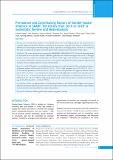Please use this identifier to cite or link to this item:
https://hdl.handle.net/20.500.14356/998| Title: | Prevalence and Contributing Factors of Gender-based Violence in SAARC Territories from 2010 to 2020: A Systematic Review and Meta-analysis |
| Authors: | Dangal, Ganesh Shrestha, Niki Khanal, Gayatri Giri, Subarna Ghimire, Anup Aryal, Shiva Aryal, Barun Babu Adhikari, Anurag Paudel, Ayusha Budhathoki, Pravash Shrestha, Dhan Bahadur |
| Citation: | DangalG., ShresthaN., KhanalG., GiriS., Ghimire A., AryalS., AryalB. B., AdhikariA., PaudelA., BudhathokiP., & ShresthaD. B. (2022). Prevalence and Contributing Factors of Gender-based Violence in SAARC Territories from 2010 to 2020: A Systematic Review and Meta-analysis. Journal of Nepal Health Research Council, 20(01), 1-11. https://doi.org/10.33314/jnhrc.v20i01.4011 |
| Issue Date: | 2022 |
| Publisher: | Nepal Health Research Council |
| Article Type: | Review Article |
| Keywords: | Domestic violence Gender-based violence Pregnancy; women. |
| Series/Report no.: | Jan-March, 2022;4011 |
| Abstract: | Abstract Background: Gender-based violence is a key global concern due to the high prevalence and increased socio-economic burden for survivors. However, estimation of the prevalence of gender-based violence is difficult due to differences in study design and underreporting of abuse, especially in developing nations. Therefore, we conducted this study to estimate the prevalence of Gender-based violence among women living in the SAARC region. Methods: The review protocol was registered in PROSPERO (CRD42020219577). Preferred Reporting Items for Systematic Reviews and Meta-Analyses (PRISMA) guidelines were followed throughout the review. A thorough database search was conducted to identify studies done in the SAARC region. Title and abstract screening were done in Covidence, followed by a full-text review. Data were extracted and pooled for analysis using the inclusion and exclusion criteria. Subgroup analysis was done where possible. Results: A total of 76 studies were included in the systematic review and metaanalysis. The community prevalence of domestic violence (DV) was 43.8% (95% CI, 35.1% - 52.9%), GBV prevalence was 34.9% (95% CI, 30.2% - 39.9%) and IPV prevalence was 39.8% (95% CI, 30.7% - 49.6%). GBV prevalence was highest in illiterate women [54.2% (95% CI, 46.8% - 61.5%)] and lowest among women with higher than secondary level education [23.1% (95% CI, 16.2% - 32.0%)]. The prevalence of GBV among women in pregnancy or postpartum period was 32.3% (95% CI, 25.1% - 40.4%, I2: 98.64), while among female sexual workers, the prevalence of Gender-based violence was 42.1% (95% CI, 28.1% - 57.5%, I2: 99.25). Conclusions: There is a high prevalence of Gender-based violence in the SAARC region. Higher socioeconomic status and educational status are protective factors for Gender-based violence. However, more studies using validated tools are needed to understand the true extent of the problem. Keywords: Domestic violence; gender-based violence; pregnancy; women. |
| Description: | Review Article |
| URI: | http://103.69.126.140:8080/handle/20.500.14356/998 |
| ISSN: | Print ISSN: 1727-5482; Online ISSN: 1999-6217 |
| Appears in Collections: | Vol. 20 No. 01 (2022): Issue 54 Jan-March, 2022 |
Files in This Item:
| File | Description | Size | Format | |
|---|---|---|---|---|
| 4011-Manuscript-27860-1-10-20220606.pdf | Fulltext Article. | 1.16 MB | Adobe PDF |  View/Open |
Items in DSpace are protected by copyright, with all rights reserved, unless otherwise indicated.
